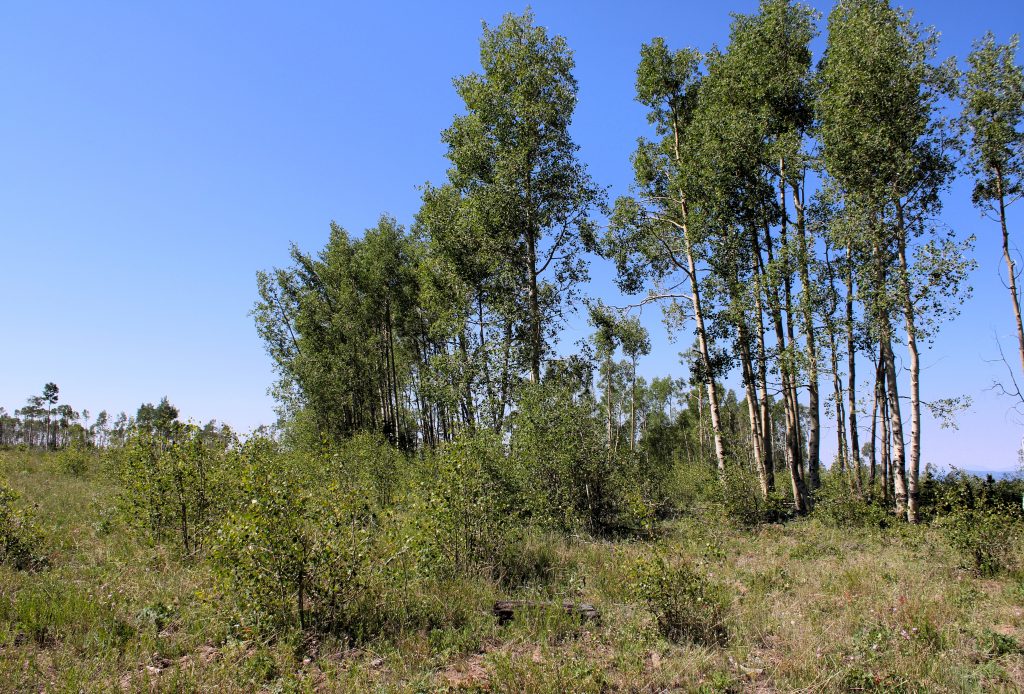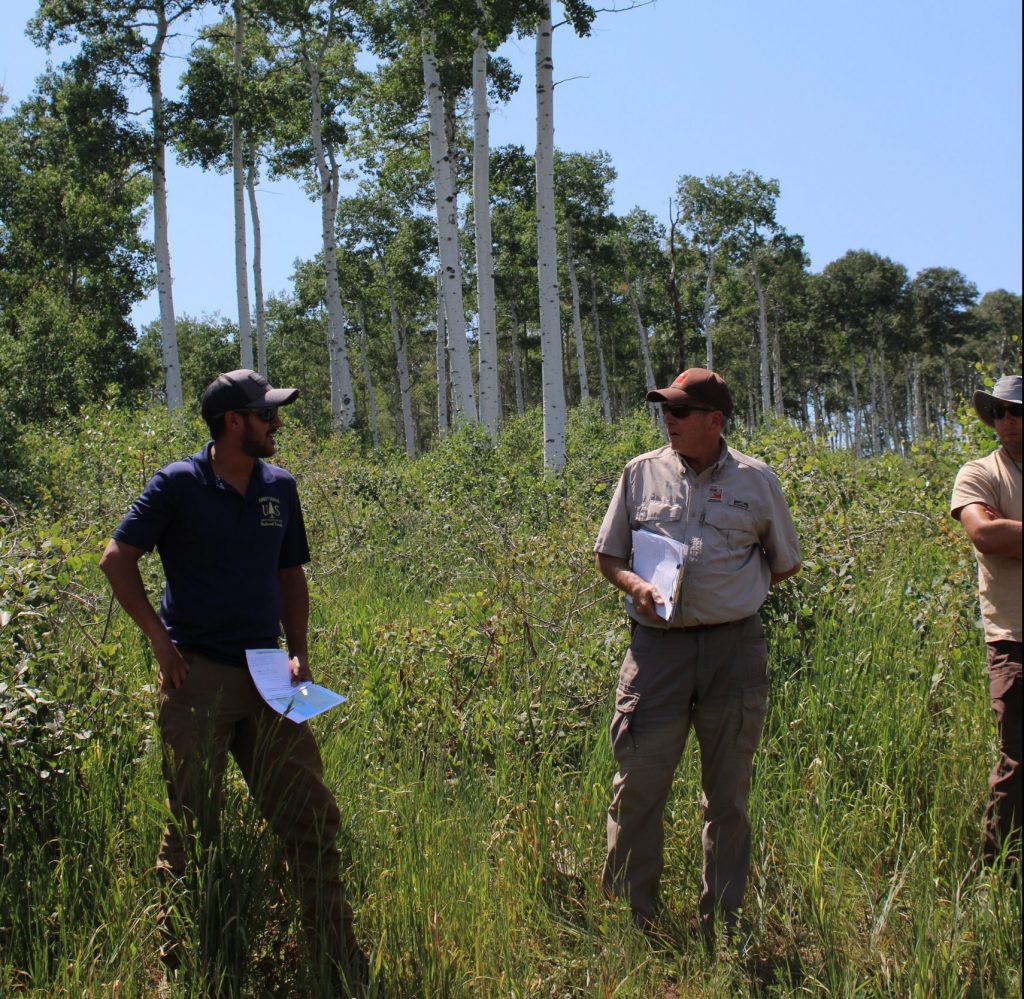Partners Tour Ongoing Restoration Efforts in Utah
EDGEFIELD, S.C. — On July 10, partners with the Utah Watershed Restoration Initiative gathered to tour various project sites and witness the ongoing landscape restoration efforts firsthand. The National Wild Turkey Federation has proudly partnered with the initiative since its inception in 2006.
Utah's Watershed Restoration Initiative is a partnership-based program in Utah to improve high-priority watersheds throughout the state. This year, the NWTF funded 26 projects for 2025, with $171,400 allocated through WRI.
NWTF staff and partners had the opportunity to tour two of these projects and observe the positive impact of past funding on the landscape, discussing how future funds will further advance the current work.
Mill Hollow Aspen Restoration Phase II

The Mill Hollow Aspen Restoration Phase II project is located on Tabby Mountain in Duchesne County, Utah. The NWTF provided $5,000 for this project, which will use mechanical treatments to remove encroaching conifer from the aspen stands to encourage aspen regeneration. This work aims to provide healthy and diverse habitats for various wildlife species and enhance the area's resilience against future insect and disease infestations. Additionally, the project will reduce the fire risk to Wildland-Urban Interface communities surrounding the area. The WUI zone refers to regions where structures and human development intermingle with undeveloped wildland or vegetative fuels.

Attendees also toured Phase I of the project, which demonstrates the positive impact the completed work has had on the landscape five years after restoration. At this stage, managers can remove barriers set up to keep out cattle, wildlife, and human presence, allowing the regenerating aspens time to become well-established and survive foraging. Now, wildlife can re-enter the area with improved habitat, and new recreational opportunities are available for local residents. Additionally, the unmarketable timber used to create the fencing will become available for residents to salvage for firewood use.
"In this project, they are also documenting wildlife and grazing impacts on aspen regeneration," said Chuck Carpenter, NWTF district biologist for Utah, Idaho, Arizona and New Mexico. "To do this, they have three different fenced areas. One log fence is stacked roughly ten feet high to keep out grazing cattle, deer, elk, and moose. The second group is designed to exclude only the cattle and allow all the wild ungulates in; this fence is roughly four feet high. The third area has no fencing at all, allowing cattle and wildlife to feed freely. They are still collecting data on how these exclusions have affected aspen regeneration, but we are excited to see the results and be a part of it."

Strawberry Ridge Aspen Regeneration and Watershed Restoration

The tour also highlighted the Strawberry Ridge Aspen Regeneration project, which thinned 260 acres of aspen to enhance vegetation diversity for the benefit of big game and both game and non-game bird species. This thinning will increase forage by opening the understory and promoting forage growth.
Additionally, recreational benefits will improve with increased access to dispersed recreation sites for camping and hiking. Long-term benefits will also include greater hunting opportunities as the numbers of big game and small game increase in the area.

Upcoming in 2025, the Watershed Restoration project on Strawberry Ridge will continue to enhance wildlife habitat and improve forest health for aspen and conifer stands in the Strawberry Ridge area. The NWTF has contributed $7,500 to this project.
Managers plan to target 881 acres with lop and scatter and mastication treatments within conifer stands around Daniel's Summit and Bryant's Fork, where many homes are located within this WUI zone. Additionally, they will reconstruct nearly a mile of fence to complete a riparian exclosure, similar to the fencing constructed for the Mill Hollow Aspen Restoration project. Noxious weed treatments will be conducted on 101 acres south of Horse Creek.
Beyond enhancing wildlife habitat, these treatments will create healthier landscapes, reduce vegetative fuels and keep communities safer from catastrophic wildfires.

"Aspen conservation and projects that focus on promoting early successional growth are vital for enhancing biodiversity, improving wildlife habitats, and increasing forest resilience to wildfires, ensuring a balanced and healthy ecosystem,” Carpenter said.
The conservation work accomplished through the Watershed Restoration Initiative also helps conserve wild turkeys in Utah and bolsters the NWTF’s Four Shared Values of Clean Water, Healthy Forests and Wildlife Habitat, Resilient Communities and Robust Recreational Opportunities.
These Four Shared Values are integral to all aspects of the NWTF mission. They also impact many other areas of our daily lives, contributing to a better world. By defining and sharing these values, we can collaborate with more partners who are equally passionate about these principles, greatly enhancing our mission to conserve wild turkeys and preserve our hunting heritage.
About the National Wild Turkey Federation
Since 1973, the National Wild Turkey Federation has invested over half a billion dollars into wildlife conservation and has positively impacted over 23 million acres of critical wildlife habitat. The NWTF has also invested over $9 million into wild turkey research to guide the management of the wild turkey population and to ensure sustainable populations into perpetuity. The organization continues to deliver its mission by working across boundaries on a landscape scale through its Four Shared Values: clean and abundant water, healthy forests and wildlife habitat, resilient communities, and robust recreational opportunities. With the help of its dedicated members, partners and staff, the NWTF continues its work to provide Healthy Habitats. and Healthy Harvests. for future generations.
